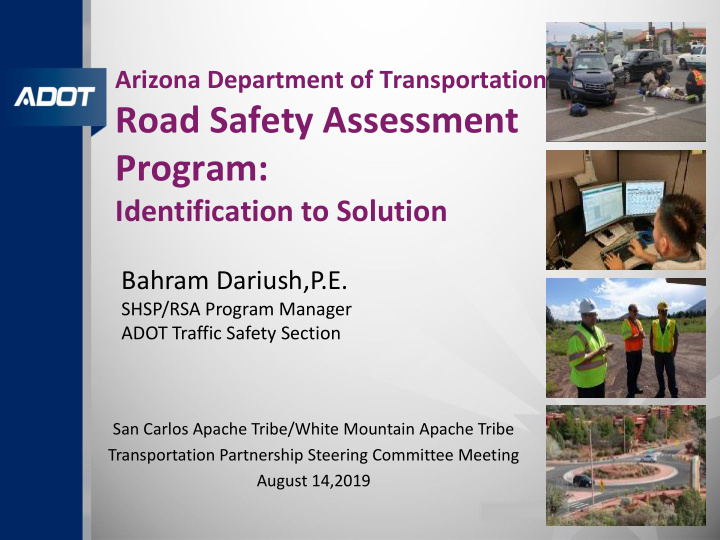



Arizona Department of Transportation Road Safety Assessment Program: Identification to Solution Bahram Dariush,P.E. SHSP/RSA Program Manager ADOT Traffic Safety Section San Carlos Apache Tribe/White Mountain Apache Tribe Transportation Partnership Steering Committee Meeting August 14,2019 1
What Is An RSA? Road Safety Assessment A formal safety performance review of an existing or future road or intersection by an independent, multi- disciplinary team. • Proactive in nature • Field observation - day, night, peak, off peak • A formal examination • Conducted by a multidisciplinary team • Conducted by a team that is independent of design team • Focused on road safety • Conducted by a team that is adequately qualified, both individually and as a team • Multimodal - peds, bikes, ADA, transit, trucks 2
RSA process: • Identify the project or existing road to be assessed • Select RSA team • Conduct a start-up meeting to review project information • Perform field observations under various conditions • Conduct RSA analysis and prepare report of findings • Present RSA findings to Project Owner/Design Team • Project Owner/Design Team prepare formal response • Incorporate findings into the project when appropriate 3
ADOT RSA Program RSA Team member pool • Law Enforcement • Traffic Engineering Agency: • Roadway Design ADOT, FHWA, NFS, Tribal. • Roadway Maintenance Municipality, County, BIA, DHS, NPS • Risk Management • Human Factors • Emergency Medical Services • Pedestrian Safety • Bicyclist Safety • Accident Reconstruction • Transit • Transportation Safety 4
RSA Process • Road owner(s) submits reques t – https://www.azdot.gov/business/tsmo/operational-and-traffic- safety/road-safety-assessments • RSA Team is assembled • RSA is conducted • Formal Findings Report sent to owner(s) • Owner(s) submits written implementation plan 5
RSA Application One Page to provide owner input and concern. Includes: • Reason for the RSA • Crash Experience • ADT(Average Daily Traffic) • Road Owner • Future Development 6
RSA Application Scoring • Priority • Higher scores first • Fatal/Serious Injury – Consultant • Minor injuries or safety concerns- ADOT staff • Outcome • K/A crashes may make state or HSIP funding eligible 7
Internal RSA Application Scoring Typical ADOT Timeline from Application: • Field Review 3 months • Final Report 5 months • HSIP Project 3-5 years Reasons: • Scoping • Competitive bidding • Scheduling 8
ADOT RSA Program • Conduct 12 RSAs per year • All stages: scoping, design, construction, existing • Urban and rural • City, county, state, tribal, and federal locations • RSA annual report 9
RSA Procedures • Site visits • Analysis • Start-up meeting • Presentation of findings 10
(1) Start-up Meeting • Introductions • Exchange of information • RSA process • Schedule 11
(1) Start-up Meeting • Assessment site, including constraints, challenges, or known issues • RSA process • Schedule 12
(2) Field Review • Observe road user characteristics. • Observe surrounding land uses. • Observe link points to the adjacent transportation network. 13
(2) Field Review • Review Crash data • RSA team in one vehicle. • Designate a driver and secretary. 14
(2) Field Review • Drive the site • Many times (day and night) • Drive all approaches • Make all turns 15
(2) Field Review Look for: Sight distance obstructions • Roadside hazards • Driveway issues • • AND good practices 16
(2) Field Review • Observe conditions during: • Peak and off-peak traffic periods • Day and night conditions 17
(2) Field Review • Walk the site 18
(3) RSA Analysis • Workshop setting • Review information and crash data • Identify, prioritize, and mitigate safety issues • Consider the 4 E’s Engineering Enforcement Education Emergency response 19
(4) Presentation of Findings: Preliminary Findings Meeting • RSA team, road agency • Discuss preliminary findings and possible solutions • Use results to write RSA report 20
(4) Presentation of Findings: RSA Report • Documents the results of the RSA • Identifies and prioritizes safety issues • Includes suggestions for improvements 21
Response Letter • Prepared by the road agency (with possible input from designer) • For each safety issue, identifies what action will (or will not) be taken with a brief explanation • Part of the RSA record 22
RSA Benefits • Proactive • Holistic • Independent • Systematic • Low cost • Thorough 23
ADOT RSA Program RSA process benefits RSA Findings: • Reflect consensus of review team • Consider confounding issues: Feasibility, economic efficiency, affordability, practicality, political/institutional acceptability, legal compatibility, consistency, etc. • Focus on road user interaction • Address Human Factors and Human Behavior issues • Address roadway environment factors • Address observed conflicts and crash patterns • Improve safety of all road users 24
RSA Findings Infrastructure, user, and vehicle issues are addressed 25
4E Emphasis Mitigation measures include: • Engineering Road Safety: Crash Factors Make changes to the roadway Human Factors (95%) • Education Educate all roadway users • Enforcement Road Factors Enforce traffic laws (28%) • Emergency Response 24% 67% 4% Emergency vehicles quickly access, provide services 4% 4% Vehicle Factors (8%) 26
ADOT RSA Program RSA Progress • First RSA 2006 • 123 RSA’s to date • 28 County • 25 Municipal • 48 State • 20 Tribal • 2 NFS • 1 RSA requests are underway • 1 RSA request in the process 27
ADOT RSA Program RSA Progress Tribal RSAs conducted BIA Route 2 Oraibi/Leupp Road Ak-Chin Indian community Colorado River Indian Tribes BIA 18/Havasupai & Hualapai Tribe Kaibab Paiute Tribe Navajo Nation US 160 US 160 at Navajo Route 21, MP 343.43 Navajo Route 6, MP 36.2 – 36.5 28
ADOT RSA Program RSA Progress US 70, MP 294 to 298 US 70, San Carlos Apache Tribe San Xavier Rd/Little Nogales Drive San Xavier Road I-19 to J. Stock Road BIA – IRR 15 at SR 86 SR 73, White Mountain Apache Tribe 29
ADOT RSA Program Resources 31
Thank you! Bahram Dariush, P.E. SHSP/RSA Program Manager 602-712-2332 Bdariush@azdot.gov 32
Recommend
More recommend